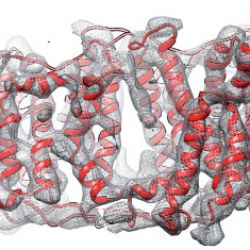
Borate transporter Bor1p appears to function according to the alternating access model
Bor1p is a secondary transporter in yeast that is responsible for boron transport, likely powered by the proton gradient across the cell membrane. It belongs to the SLC4 family, which is related to the Polyamine-organo-Cation (APC) superfamily. Their mechanism generally involves relative movements of two domains: a core domain that binds substrate and a gate domain that in many cases mediates dimerization. In collaboration with David Stoke’s Lab we combined computer simulations with cryo-electron microscopy to elucidate the conformational changes underlying transport in Bor1p1.
Our collaborators grew helical membrane crystals of Bor1p from the yeast Saccharomyces mikatae and determined a structure at ~6 Å resolution using cryo-electron microscopy. To evaluate the conformation of Bor1p in these crystals, a homology model was built based on the related anion exchanger from red blood cells (AE1). This homology model was fitted to the cryo-EM density map using the Molecular Dynamics (MD) Flexible Fitting method and then relaxed by all-atom MD simulation in explicit solvent and membrane.
Bor1p in outward facing (OF) and inward facing (IF) conformations. (A) OF model with HOLE surface showing accessibility of the central pore from the periplasmic side. (B) IF conformation, showing cytoplasmic accessibility. (C) Water density from MD simulation for OF Bor1p. (D) Water density from MD for IF.
Mapping of water accessibility indicates that the resulting structure represents an inward-facing conformation. Comparisons of the resulting Bor1p model with the X- ray structure of AE1 in an outward-facing conformation, together with MD simulations of inward- facing and outward-facing Bor1p models, suggest rigid body movements of the core domain relative to the gate domain. These movements are consistent with the rocking-bundle transport mechanism described for other members of the APC superfamily, but do not agree with an elevator model for the closely related Bor1 transporter, recently proposed based on X-ray crystallography2 but without the support of computer simulations.
References
- a N. Coudray, S. Seyler, R. Lasala, Z. Zhang, K. M. Clark, M. E. Dumont, A. Rohou, O. Beckstein, and D. L. Stokes. Structure of the SLC4 transporter Bor1p in an inward-facing conformation. Protein Sci, 26(1):130–145, 2017. DOI: 10.1002/pro.3061
- a B. H. Thurtle-Schmidt and R. M. Stroud. Structure of Bor1 supports an elevator transport mechanism for SLC4 anion exchangers. Proceedings of the National Academy of Sciences, 113(38):10542–10546, 2016. DOI: 10.1073/pnas.1612603113



Discuss: “Borate transporter Bor1p appears to function according to the alternating access model”